Study of the Dynamic Reaction Mechanism of the Cable-Stayed Tube Bridge under Earthquake Action
Abstract
:1. Introduction
2. Theory and Simulation
2.1. Dual Theoretical Framework
2.1.1. Additive Mass Theory
2.1.2. Fluid–Structure Interaction Theory
- Fluid control equation:
- Equation of conservation of mass:where is the density; is the time; and , , are the velocity components in the three directions , , , respectively.
- Momentum conservation equations:where is the Hamiltonian differential operator, ; is the pressure on the surface of the fluid element; , , are the unit mass forces in the , , directions, respectively; and are the components of the viscous stress on the surface of the element.
- Energy conservation equation:where is the total energy of the fluid, is the effective heat conduction coefficient, is the enthalpy, is the enthalpy of component , is the diffusion flux of component , and is the chemical reaction heat and other user-defined volume heat source terms.
- Governing equations for solids:
- The governing equation of fluid–structure interaction:
2.2. A Finite Element Model of Straddling Oil and Gas Pipelines
Types and Parameters of Each Component of the Cable-Stayed Tube Bridge
2.3. Analysis of Structural System Dynamic Characteristics
- The cable-stayed straddling oil and gas pipeline structure is a flexible structure, the natural frequency of dynamic characteristics is small, and the distribution of the first 10 orders of natural frequency is relatively dense. Such structures belong to a dense frequency structure, which indicates that the vibration characteristics of the cable-stayed straddling oil and gas pipeline are complex, and a comprehensive investigation of the mechanical properties of the cable is imperative under earthquake action.
- Comparing and analyzing the first 10 vibration modes of the cable-stayed span structure of pipelines for oil and gas transportation, the occurrence of vibration modes primarily manifests in pairs, as is evident, with the characteristics of positive symmetry or antisymmetric. The transverse bending of the main beam is more than that of the vertical bending, which indicates that the transverse stiffness of the main beam in the structural system is smaller than the vertical stiffness. Therefore, in the following seismic response and analysis of harm, the focus is placed on the impact of transverse seismic waves on both the structure and cable.
- The main beam’s bending in the transverse direction mainly occurs on both sides of the span, showing a symmetrical structure as a whole, and the flexing of the primary girder also directly affects the displacement change in the cable. Therefore, when analyzing the response of the cable, it is necessary to study the dynamic effect of the cable corresponding to the mid-span position of the left and right sides.
3. Results
3.1. Analysis of Time-History Response of Cable under Earthquake Action
3.1.1. Cable Stress Response Analysis
3.1.2. Analysis of Cable Displacement Response
3.2. Analysis of Distribution Law of Cable Properties under Earthquake Action
3.2.1. Cable Stress Change Distribution Law Analysis
- Due to the interaction between the fluid’s flow characteristics and the bridge’s structural properties, both approaches result in an almost symmetrical distribution of stress on either side of the structure.
- Under the action of fluid–structure coupling, the stress distribution in the left (right) side span is large and stable, while the stress distribution on both sides is small. The maximum value appears in cables 15 and 16, and the minimum value appears in cables 27 and 28. Under the additional mass method, the left (right) side span distribution stress is larger in front of the middle of the span, and on both sides of the span distribution, the stress is smaller. The maximum value appears in cables 5 and 6, the minimum value appears in cables 27 and 28, and the stable region is distributed in the middle and behind the span (cables 15–22).
- The overall uniformity of the left (right) side of the main tower by the fluid–structure interaction method is less than that by the additional mass method. Compared with the sudden and uneven distribution of cable stress under the additional mass method, the stress of the cable under the fluid–structure interaction is more stable and has no sudden change. The maximum stress under the fluid–structure interaction is nearly 70% smaller than that under the additional mass.
3.2.2. Analysis of Distribution Law of Cable Displacement Change
- As a symmetrical structure is adopted in the design of the cable-stayed pipe bridge, the two sides of the structure produce similar displacement distribution under the action of the two methods, and the left and right sides are almost symmetrical.
- Under the two methods, the large displacement area of the left (right) side of the structure is concentrated in the middle of the span; the maximum displacement occurs in cables 21 and 22, the cable distributed on both sides of the span has a small displacement, and the minimum displacement occurs in cables 27 and 28.
- The displacement size of the left (right) side of the main tower using the fluid–structure interaction method is less uniform than that using the additional mass method. Unlike the additional mass approach, the displacement of the cable reaction under fluid–structure coupling is relatively stable, and there is no abrupt change. In addition, the maximum displacement value under the fluid–structure coupling is reduced by nearly 67% compared to the maximum displacement value under the additional mass.
- According to the analysis of Figure 7, it is evident from the data that the fluid’s impact can reduce the response of the structure and play a buffer role, thus reducing the vibration of the structure and making its deformation smaller, which is also the reason why the stress and displacement on both sides of the main tower under the fluid–structure coupling are smaller than the additional mass. Especially under the external excitation of natural disasters such as earthquakes, wind loads, and water loads, the fluid–structure interaction method can reflect the change in structural stiffness to better reflect the vibration characteristics of the structure. By simulating the dynamic interaction between the fluid and the structure, the vibration mechanism of the structure can be predicted more accurately, revealing a closer approximation to the actual circumstances.
4. Conclusions
- By establishing a three-dimensional geometric model in the realm of finite element analysis, setting the parameters of the structural components, selecting the material constitutive model, and setting the fluid–structure coupling model, it is evident that the stress and displacement on the left and right sides of the structure show an antisymmetric distribution, which is mainly due to the asymmetry of the fluid force and the difference between the damping and stiffness on both sides of the main tower. Through the analysis of vibration modes, it can be seen that, as a flexible structure, the cable-stayed straddle oil and gas pipeline has complex vibration characteristics and a small natural frequency. The vibration modes of such tight-frequency structures are mostly positive-symmetric or antisymmetric. It is especially significant in the transverse flexure of the primary girder, indicating that its transverse stiffness is relatively small. Therefore, the impact caused by the influence of lateral fluctuations should be given special consideration on the main beam and cable, especially the dynamic effect of the cable in the middle of the span on both sides.
- By analyzing the distribution of cable stress under earthquake action, it is evident that, compared with the additional mass method, the left (right) side stress of the main tower under the method of interaction between fluid and structure is generally smaller, and its maximum stress value is reduced by nearly 70%. Under the two methods, the cable on both sides of the structure shows a small stress response. Further data indicate that the implementation of the fluid–structure interaction technique results in a predominant concentration of high stress levels within the mid-span part of the structure, and the amplitude difference in the stress is small, showing a stable reaction phenomenon with small sudden changes. In contrast, when the additional mass method is adopted, the structural stress under the action of seismic waves is mainly distributed on both sides of the span of the structure, the difference between the stress and the deformation amplitude is significant, and the data show instability accompanied by sudden change.
- Through the analysis of the distribution of cable displacement under earthquakes, it is evident that whether the methodology for the interaction between fluids and structures or the additional mass method is adopted, the area with large cable displacement is primarily located in the middle portion of the structure and back parts of the span, and the displacement generated by the cable distributed on both sides of the span is small. Further data show that, compared with the additional mass method, the displacement results to the left (right) of the central tower under the fluid–structure interaction method are smaller, and the displacement response of the cable has better stability without abrupt changes. According to the fact that the maximum displacement value is nearly 67% lower than that of the additional mass methods, the structural response can be effectively mitigated by the impact of fluid and play a buffer effect to reduce the vibration and deformation of the structure, which provides greater advantages for the structure. Secondly, due to the role of the fluid, the stiffness of the structure will change. The fluid–structure interaction method can simulate this stiffness change to better reflect the dynamic properties of the structure. Through the simulation of the interaction between the fluid and the structure, we can more accurately reveal the expected dynamic response of the structure, closer to the real circumstances, to better design the structure or take other measures to reduce the stiffness of the structure. In the fluid–structure interaction method, we can better study the dynamic reaction mechanism of the cable-stayed tube bridge structure under earthquake action to provide a reference for the cable-stayed tubular bridge’s design and analysis under seismic load.
5. Proposals for Future Research
- The fluid–structure coupling problem entails intricate interaction between the fluid and the solid, thereby making the calculation process complex and requiring extensive data and boundary conditions to be processed. In this process, we are premised on the assumption that both the fluid and the solid are continuous media and, to a certain extent, overlook the disparities in their microstructures. Given the multiplicity of damages brought about by structural vibration, on the basis of discussing the dynamic response mechanism of the cable-stayed tube bridge structure in detail, we should carry out long-term dynamic monitoring of the cable-stayed tube bridge and collect the actual response data under dynamic load, thereby fine-calibrating and optimizing the existing finite element model. Additionally, cutting-edge approaches such as advanced materials, innovative optimization of structural design, and active control technology need to be explored to identify more effective vibration reduction and protection measures so as to significantly decrease the vibration amplitude and frequency of the cable and, accordingly, enhance the overall safety and durability of the cable-stayed tube bridge.
- The impact of earthquakes on structures is complex and nonlinear. The core of this study is the structural vibration caused by ground motion, which is manifested as the external load directly acting on the structural system in the form of inertial force. However, under this dynamic action, structures such as the cable will experience elastic–plastic deformation, damage to material properties, and nonlinear interactions between contact surfaces. In addition, by using the additional mass method, we assume that the response of the cable is linear and the additional mass is evenly distributed on the cable, so we ignore the influence of nonlinear factors on the dynamic reaction and the uneven mass distribution that may exist in practical engineering, etc., so If only the linear analysis method based on inertial forces is used, the effect of these nonlinearities may be overlooked. Therefore, future research must further analyze the nonlinear dynamic characteristics of the structure while exploring how the structural system responds to the site vibration.
- In this study, we adopted a simplified, consistent incentive input method. However, according to the depth of the current academic research, this method of consistent incentive input, to some extent, ignores the propagation speed of seismic waves and the subtle time difference generated when the different support points receive the seismic wave, the so-called traveling wave effect. For long-span bridge structures such as cable-stayed pipe bridges, the time for seismic waves to reach their various support points may be significantly different. Therefore, it is necessary to further explore and study the correlation analysis under multi-point excitation to ensure that the safety and stability of the structure are fully considered.
Author Contributions
Funding
Data Availability Statement
Acknowledgments
Conflicts of Interest
References
- Pakos, W.; Grosel, J. Reduction of cable vibrations in a cable stayed bridge under biharmonic excitation. Eng. Struct. 2019, 189, 1–10. [Google Scholar] [CrossRef]
- Jeong, S.; Lee, J.; Cho, S.; Sim, S.H. Integrated cable vibration control system using Arduino. Smart Struct. Syst. 2019, 23, 695–702. [Google Scholar]
- Meng, X.; Zhang, B.; Cao, F.; Liao, Y. Effectiveness of Measures on Natural Gas Pipelines for Mitigating the Influence of DC Ground Current. IEEE Trans. Power Deliv. 2024, 1–9. [Google Scholar] [CrossRef]
- Abdel-Ghafar, A.M.; Khalifa, M.A. Importance of cable vibration in dynamics of cable-stayed bridges. J. Eng. Mech. 1991, 117, 2571–2589. [Google Scholar] [CrossRef]
- Javanmardi, A.; Ghaedi, K.; Huang, F.; Hanif, M.U.; Tabrizikahou, A. Application of Structural Control Systems for the Cables of Cable-Stayed Bridges: State-of-the-Art and State-of-the-Practice. Arch. Comput. Methods Eng. 2022, 29, 1611–1641. [Google Scholar] [CrossRef]
- Soltane, S.; Mekki, O.B.; Montassar, S. Optimal Design of a Passive SMA Damper to Control Multi-modal Stay Cable Vibrations. J. Vib. Eng. Technol. 2023, 11, 1343–1358. [Google Scholar] [CrossRef]
- D’Auteuil, A.; McTavish, S. An investigation of rain-wind induced vibrations on stay cables in a novel range of operating conditions. J. Wind Eng. Ind. Aerodyn. 2023, 242, 105581. [Google Scholar] [CrossRef]
- Wang, X.; Guo, Z.; Huang, Y.; Xiong, L.; Yao, D.; Dong, W. Design of flexible sensor for wind pressure monitoring of stay cables. Meas. Sci. Technol. 2024, 35, 10. [Google Scholar] [CrossRef]
- Tang, H.; Xu, W.; Yi, J. Seismic performance of cable-stayed bridges under large earthquake ground motions considering the loss of stay cables. Case Stud. Constr. Mater. 2024, 20, e02888. [Google Scholar] [CrossRef]
- Wang, P.; Liu, M.; Huang, Y.; Lin, L. Influence of lateral motion of cable stays on cable-stayed bridges. Struct. Eng. Mech. 2010, 34, 719–738. [Google Scholar] [CrossRef]
- Jiang, Y. Modeling and analysis of cable vibrations in cable-stayed bridges under near-fault ground motions. Eng. Struct. 2023, 277, 115443. [Google Scholar]
- Hua, J.; Zuo, D. Evaluation of aerodynamic damping in full-scale rain-wind-induced stay cable vibration. J. Wind Eng. Ind. Aerodyn. 2019, 191, 215–226. [Google Scholar] [CrossRef]
- Weng, G.; Xie, Q.; Xu, C.; Zhang, P.; Zhang, X. Seismic response of cable-stayed spanning pipeline considering medium-pipeline fluid–solid coupling dynamic effect. Processes 2023, 11, 313. [Google Scholar] [CrossRef]
- Huang, H.; Guo, M.; Zhang, W.; Huang, M. Seismic Behavior of Strengthened RC Columns under Combined Loadings. J. Bridge Eng. 2022, 27, 6. [Google Scholar] [CrossRef]
- Zhang, J.; Zhang, C. Using viscoelastic materials to mitigate earthquake-induced pounding between adjacent frames with unequal height considering soil-structure interactions. Soil Dyn. Earthq. Eng. 2023, 172, 107988. [Google Scholar] [CrossRef]
- Schumacher, T.; Hameed, A.W.; Higgins, C.; Erickson, B. Characterization of hydrodynamic properties from free vibration tests of a large-scale bridge model. J. Fluids Struct. 2021, 106, 103368. [Google Scholar] [CrossRef]
- Dos Santos, J.D.B.; Anjos, G.R.; Savi, M.A. An investigation of fluid-structure interaction in pipe conveying flow using reduced-order models. Meccanica 2022, 57, 2473–2491. [Google Scholar] [CrossRef]
- Sangalli, L.A.; Braun, A.L. A fluid-structure interaction model for numerical simulation of bridge flutter using sectional models with active control devices. Preliminary results. J. Sound Vib. 2020, 477, 115338. [Google Scholar] [CrossRef]
- Lee, U.; Pak, C.H.; Hong, S.C. The Dynamic of a Piping System with Internal Unsteady Flow. J. Sound Vib. 1995, 182, 297–311. [Google Scholar] [CrossRef]
- Simandjuntak, S.; Lin, B.; Affendy, B.; Akther, F. Combined residual stresses and fluid-structure interaction finite element analysis on bent pipes. Mater. High Temp. 2021, 38, 351–357. [Google Scholar] [CrossRef]
- Zhu, X.; Weng, G. Study on Earthquake Failure Mechanism and Failure Mode of Cable-Stayed Pipeline Bridge Considering Fluid–Structure Coupling. Appl. Sci. 2023, 13, 9583. [Google Scholar] [CrossRef]
- Chen, Z.H.; Han, K.; Ren, F.; Zhu, W.; Lu, K.; Yang, H.; Wang, W. Influence of transverse vibration induced by fluid-structure interaction on pipeline strength. Nucl. Eng. Des. 2023, 411, 112445. [Google Scholar] [CrossRef]
- Li, T.; Rui, X.; Zhang, J.; Zhang, L. Riccati transfer equations for fluid structure interaction in liquid-filled piping systems. Heliyon 2023, 9, e15923. [Google Scholar]
- Liang, J.; Zhu, Q.; Su, Y. Influence of fluid on seismic performance of pipeline under fluid-structure interaction. World Earthq. Eng. 2007, 23, 23–28. [Google Scholar]
- Feng, L. Natural Gas Pipeline of Fluid-Structure Interaction Vibration Characteristics Research; China University of Petroleum (Beijing): Beijing, China, 2022. [Google Scholar]
- Jafari, M.; Hou, F.; Abdelkefi, A. Wind-induced vibration of structural cables. Nonlinear Dyn. 2020, 100, 351–421. [Google Scholar] [CrossRef]
- Xie, P.; Zhou, C.Y. Numerical investigation on effects of rivulet and cable oscillation of a stayed cable in rain-wind-induced vibration. J. Mech. Sci. Technol. 2013, 27, 685–701. [Google Scholar] [CrossRef]
- Zhang, P.; Yao, Z.; Liu, S.M. Analysis of fluid-structure interaction vibration characteristics of double elbow natural gas pipeline. J. Saf. Environ. 2022, 22, 115–122. [Google Scholar]
- Li, X. Analysis and Application of Fluid-Structure Interaction Vibration Characteristics of High Pressure Long Distance Pipeline; Xi’an Shiyou University: Xi’An, China, 2021. [Google Scholar]
- Bakhshizadeh, A.; Sadeghi, K.; Ahmadi, S.; Royaei, J. Damage Identification in Long-Span Cable-Stayed Bridges Under Multiple Support Excitations. Int. J. Civ. Eng. 2023, 21, 1275–1290. [Google Scholar] [CrossRef]
- Chen, Y.D. Research on Seismic Vulnerability of Long-Span Railway Cable-Stayed Bridge System Based on OpenSees Software; Southwest Jiaotong University: Chengdu, China, 2018. [Google Scholar]
- Xie, W.; Sun, L.M. Lateral seismic failure mode and damage control analysis of ultra-long cable-stayed Bridges. J. Vib. Eng. 2013, 26, 915–926. [Google Scholar]
- Hu, Q.A.; Wen, F.; Liu, J.X. Simulation analysis of tower instability of Cable-stayed bridge under large earthquake. J. Xi’an Univ. Archit. Technol. Nat. Sci. Ed. 2006, 349–352. [Google Scholar]
- Zheng, Y.G.; Cao, L.; Mao, H.G. Dynamic mechanical characteristics during pipeline cleaning of a cable-stayed bridge crossing the Fujiang River. Eng. Mech. 2000, 66–74. [Google Scholar]
- Xiao, B.; Zhou, Y.L.; Gao, C.; Cao, Y.; Shi, S.; Liu, Z. Analysis of Vibration Characteristics of Flow pipeline considering Additional Mass of Fluid. Vib. Shock. 2021, 40, 182–188. [Google Scholar]
- Zhu, H.J. ANSYS 14.5 Thermal Fluid-Structure Coupling Practical Guide; Posts and Telecommunications Press: Beijing, China, 2014. [Google Scholar]
- Tian, S.G.; Zhang, A.J.; Ren, W.Y.; Wang, T. Seismic response analysis of offshore wind power foundation based on fluid-solid coupling. Chin. J. Rock Mech. Eng. 2015, 34, 155–165. [Google Scholar]
- Clough, R.W.; Penzien, J. Dynamics of Structures, 3rd ed.; Computer & Structures, Inc.: Berkeley, CA, USA, 2003. [Google Scholar]


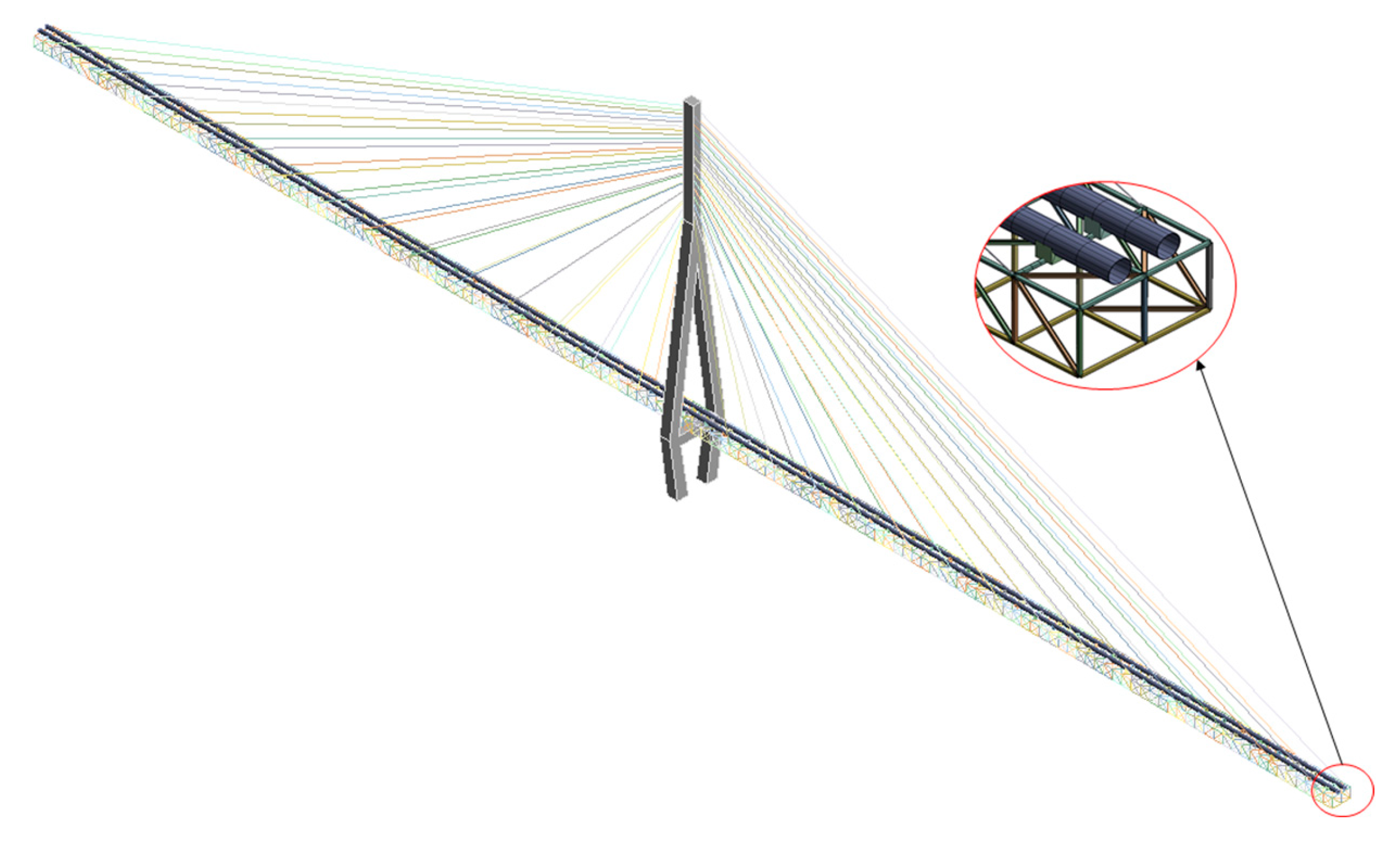
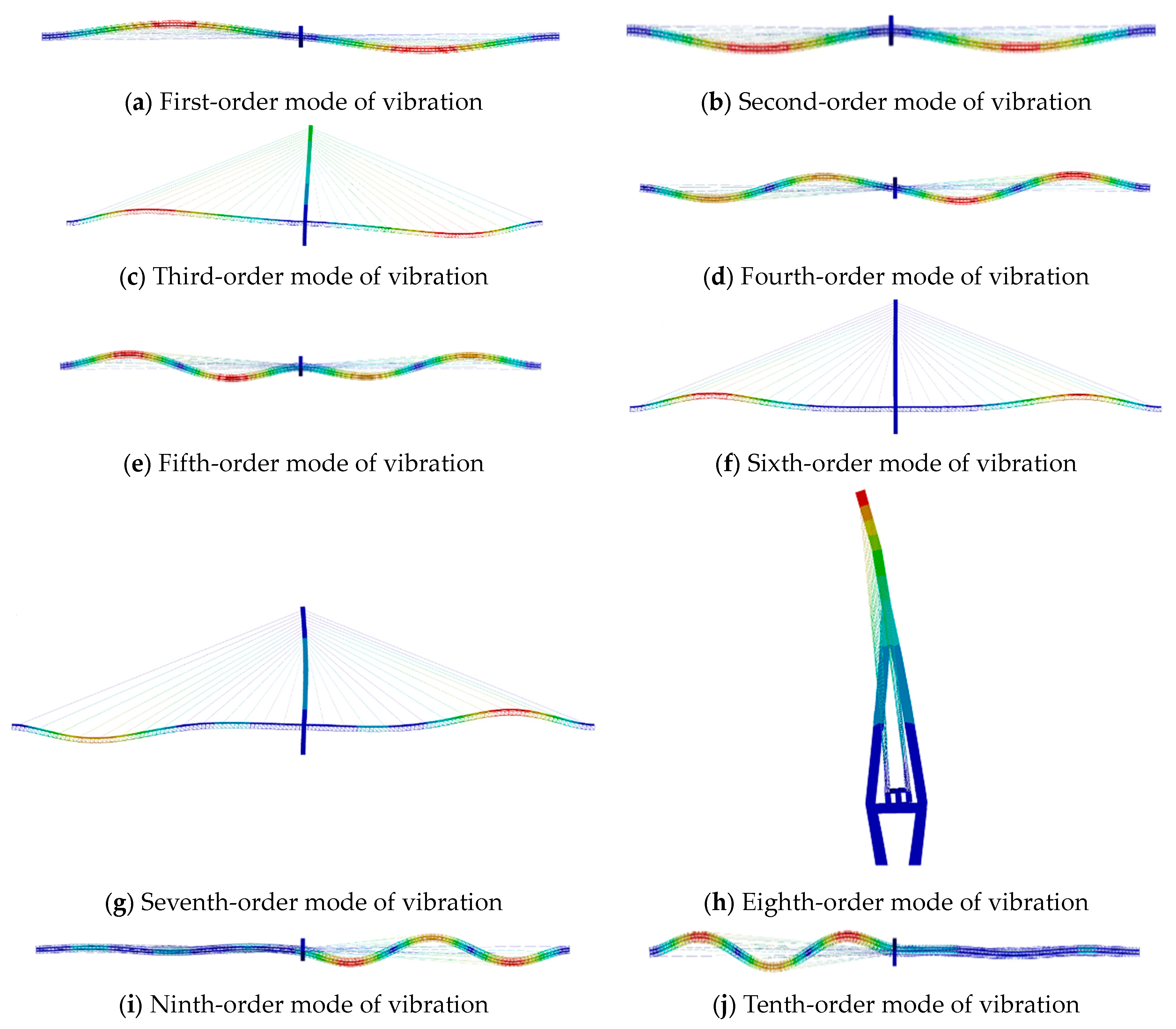
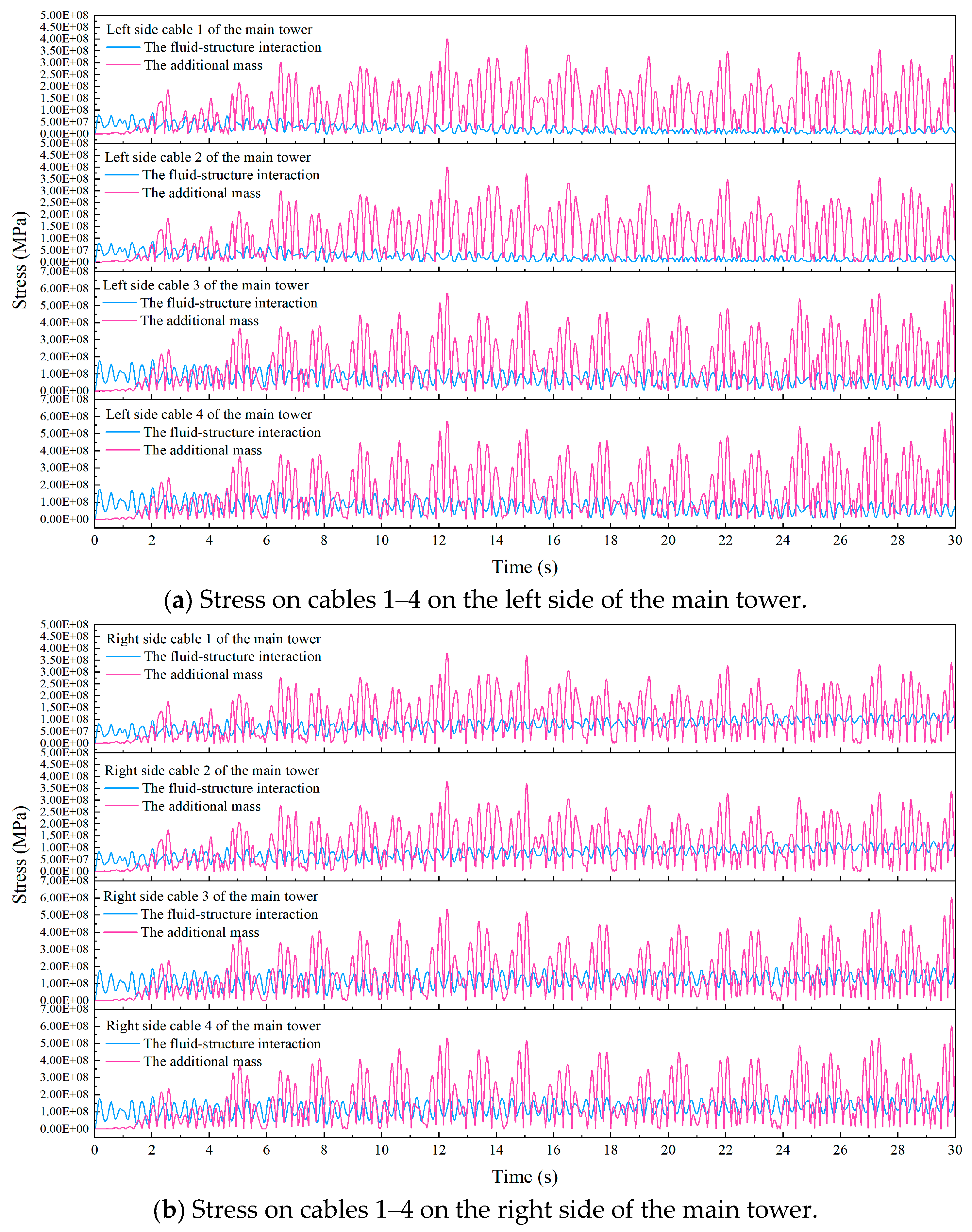


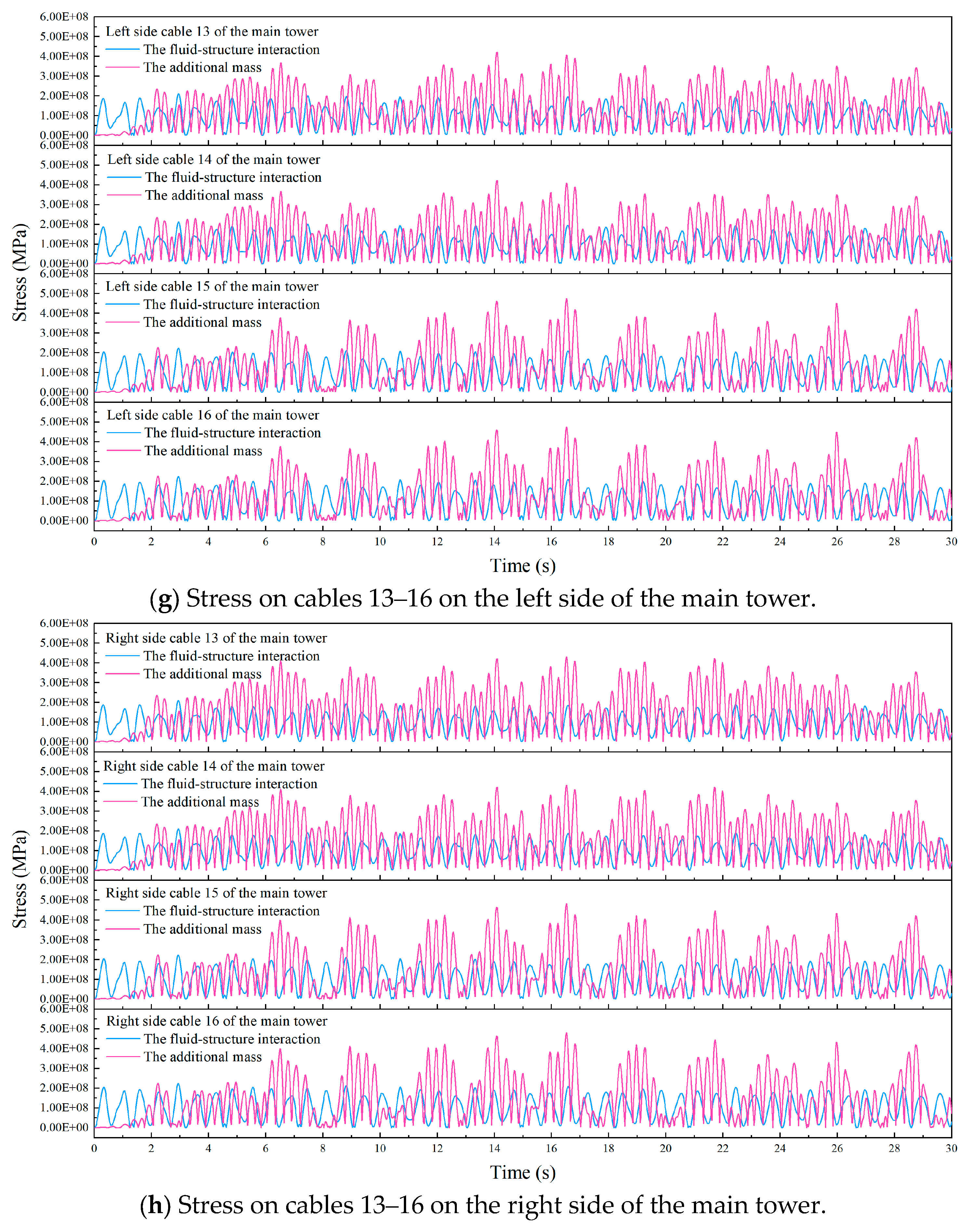
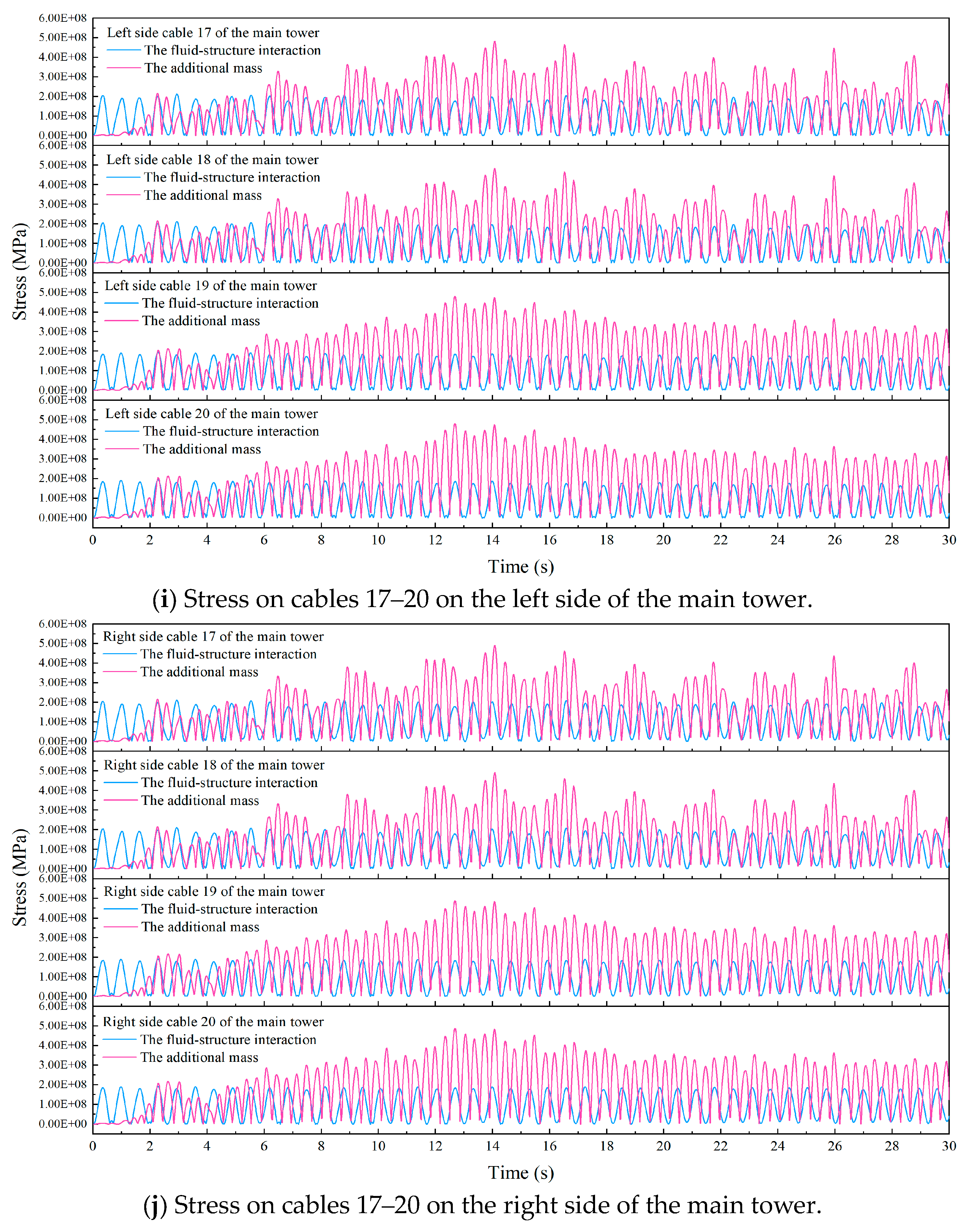

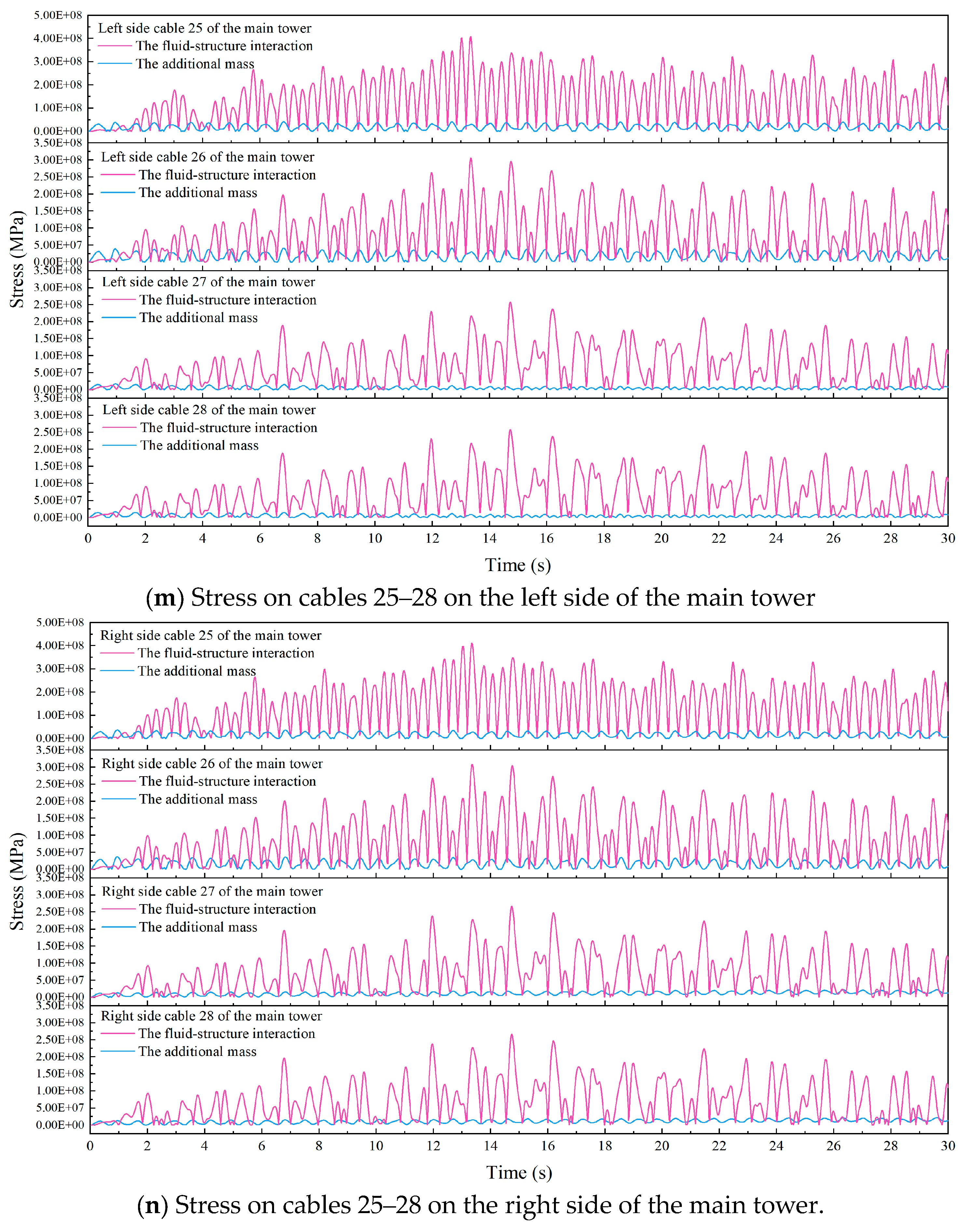
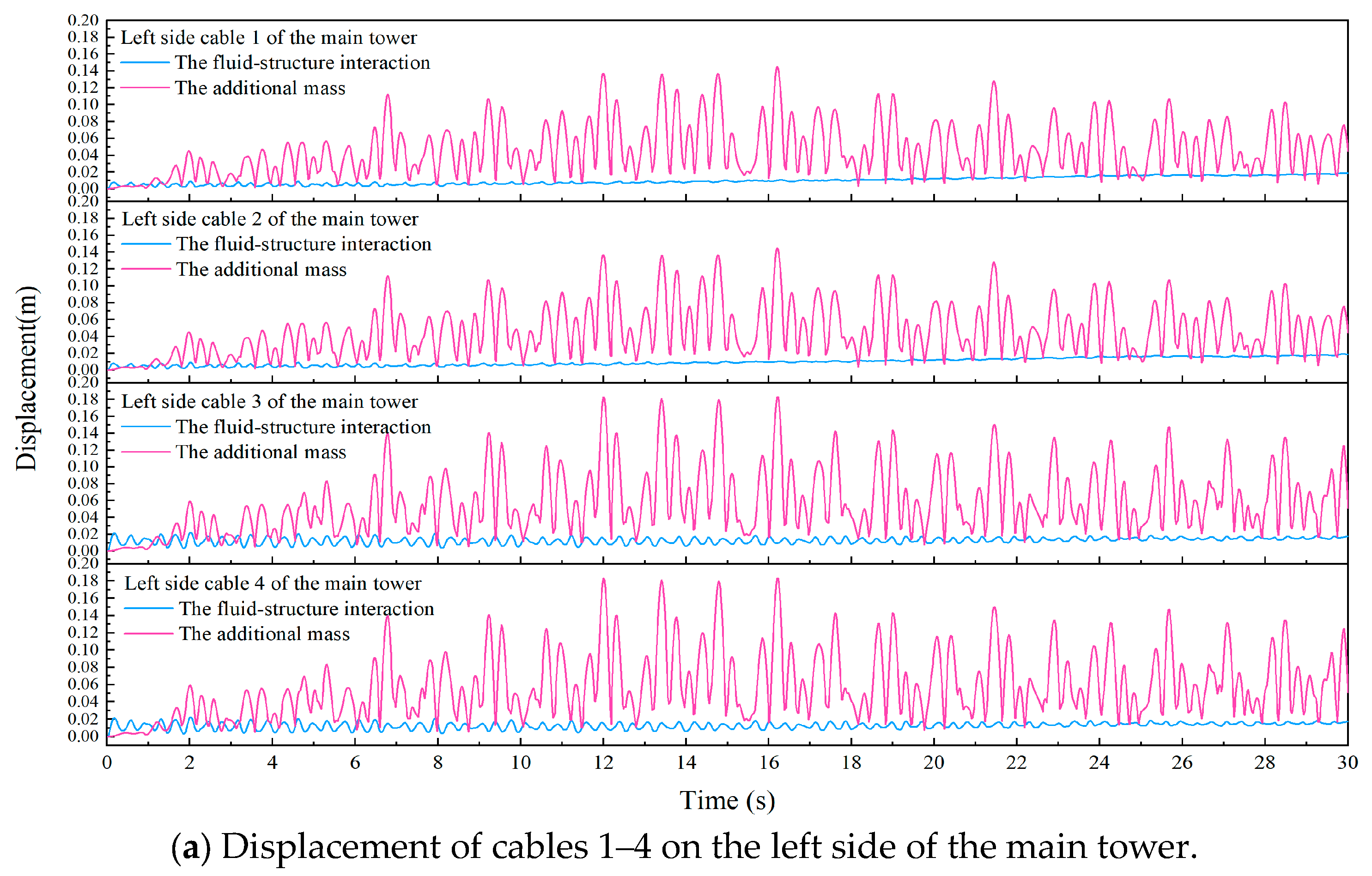
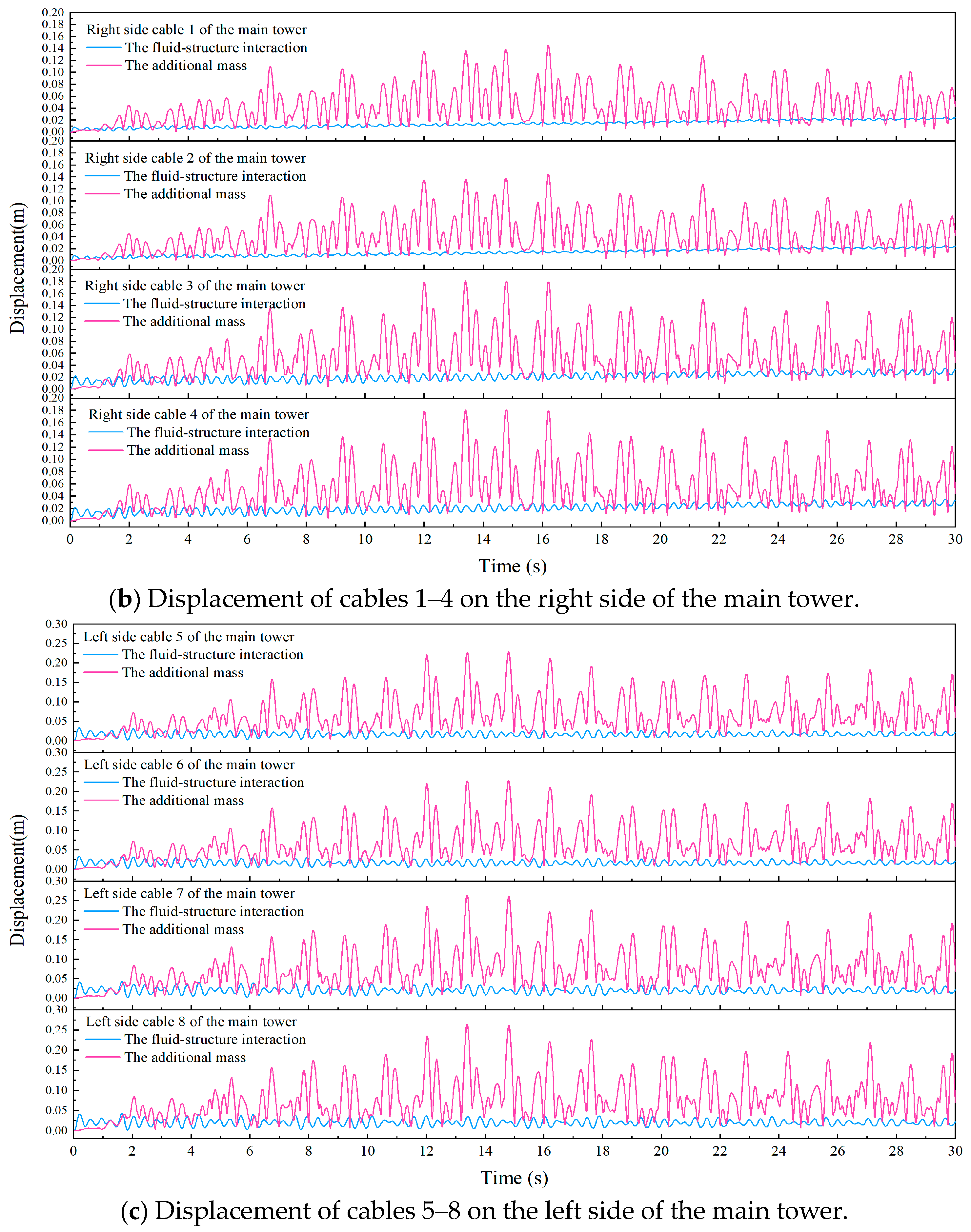
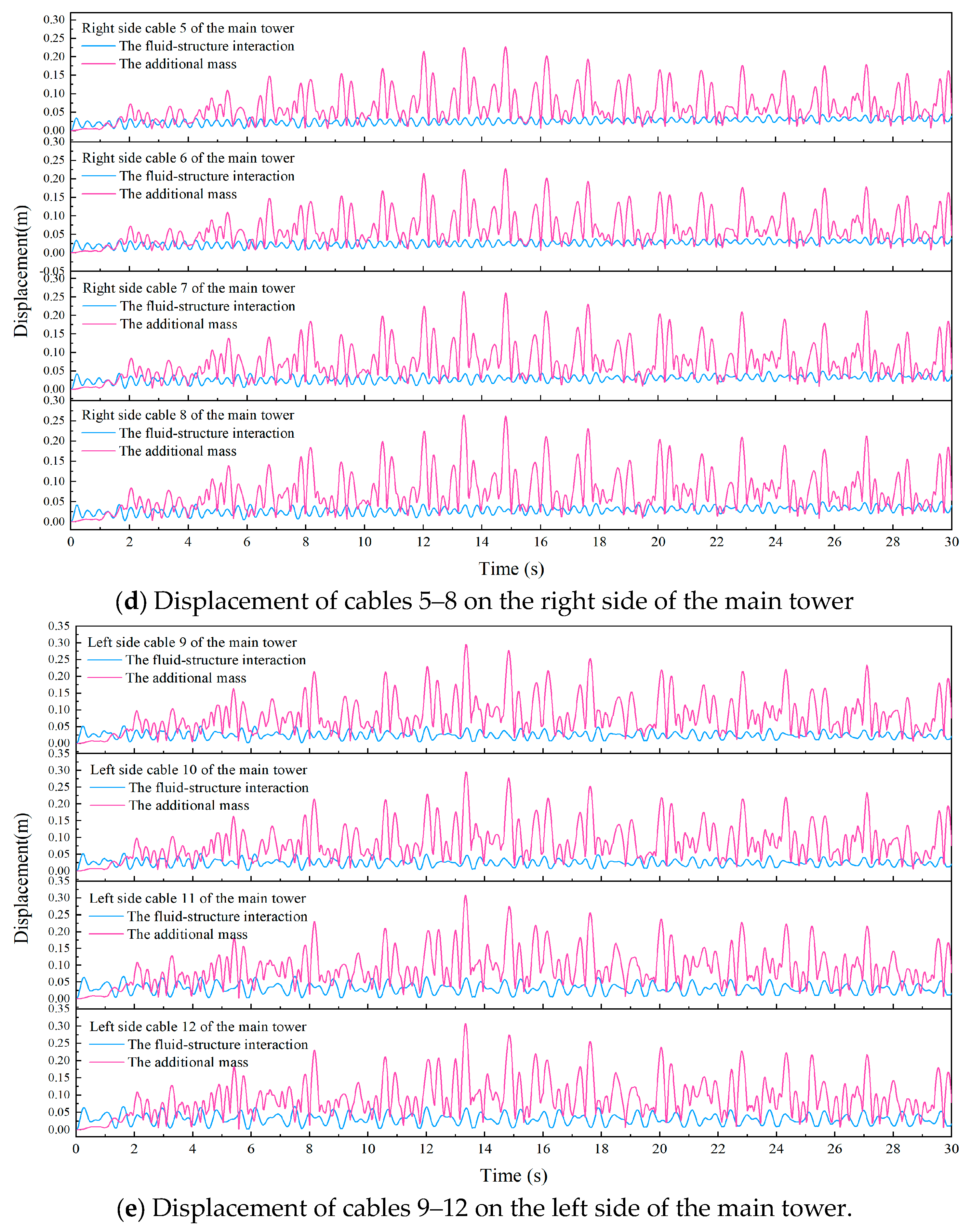



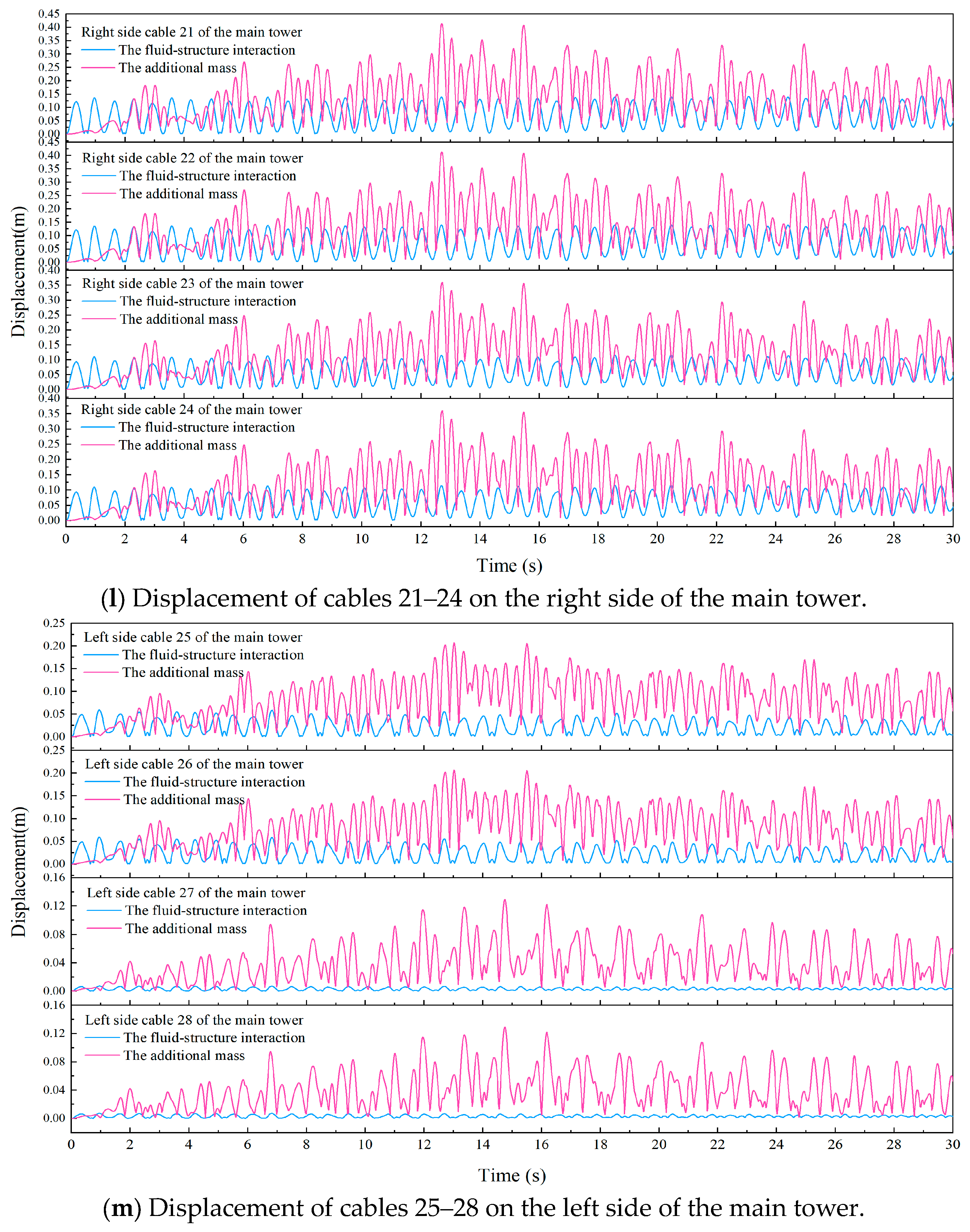
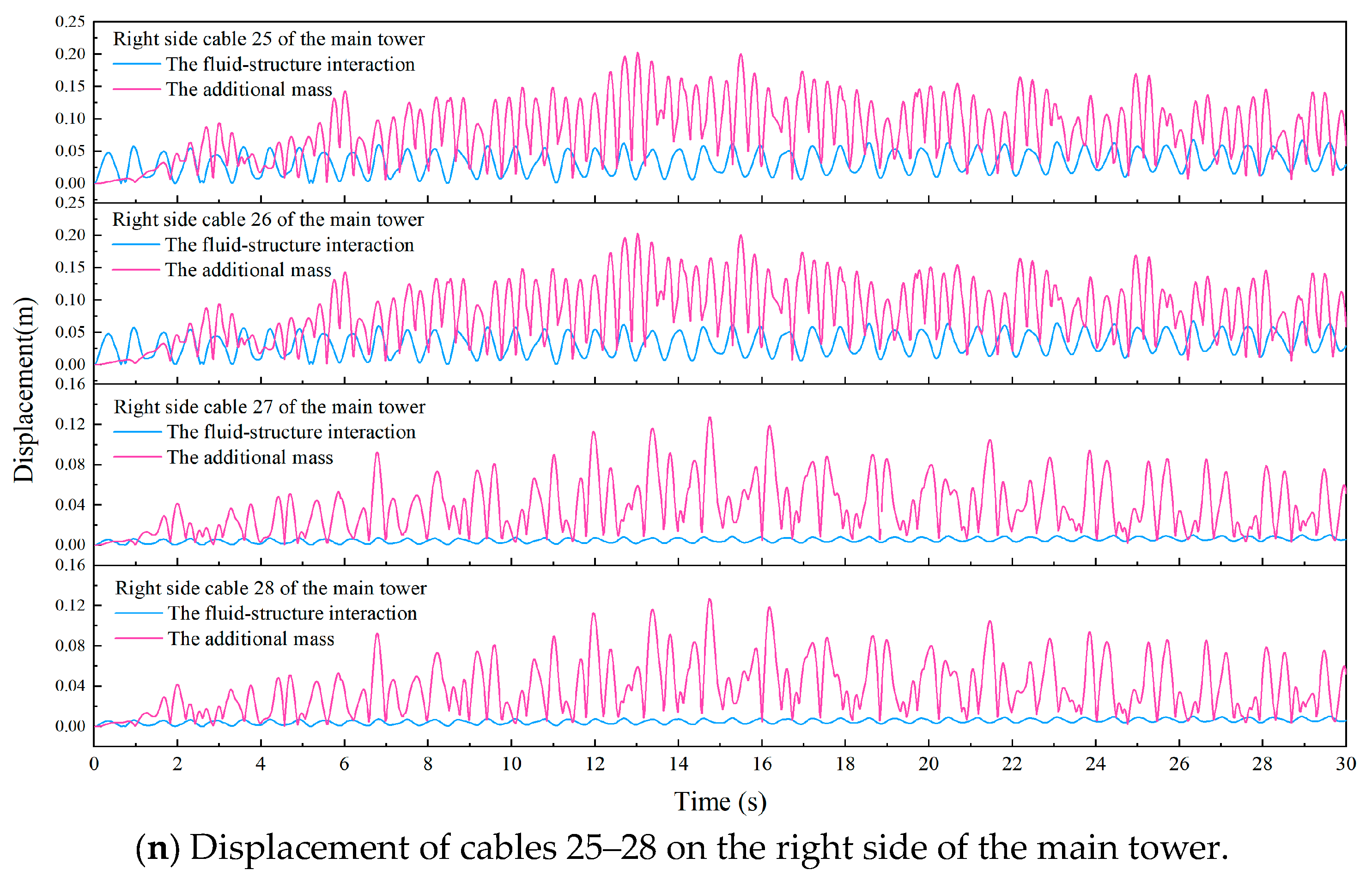


| Components | Materials | Density (kg/m3) | Poisson’s Ratio | Modulus of Elasticity (MPa) | Yield Strength (MPa) |
|---|---|---|---|---|---|
| Bridge tower | Q345 steel | 7850 | 0.3 | 2.06 105 | 378 |
| Truss beams | Q345 steel | 7850 | 0.3 | 2.06 105 | 378 |
| Bearings | Cast iron | 7850 | 0.3 | 1.5 105 | 400 |
| Pipes | X60 | 7850 | 0.3 | 2.06 105 | 425 |
| Dragline | Galvanized steel rope | 5200 | 0.3 | 2.0 105 | 1670 |
| Order | Frequency of Additional Mass (Hz) | Frequency of Fluid–Structure Interaction (Hz) | Mode Characteristics |
|---|---|---|---|
| 1 | 0.45006 | 0.46261 | Main beam antisymmetric transverse bending |
| 2 | 0.47603 | 0.4897 | Main beam symmetric transverse bending |
| 3 | 0.76706 | 0.75771 | Main beam antisymmetric vertical bending |
| 4 | 1.1782 | 1.195 | Main beam antisymmetric transverse bending |
| 5 | 1.2132 | 1.2297 | Main beam symmetric transverse bending |
| 6 | 1.5338 | 1.674 | Main beam symmetric vertical bending |
| 7 | 1.6321 | 1.7581 | Main beam antisymmetric vertical bending |
| 8 | 2.0311 | 1.7613 | Bridge tower transverse bending |
| 9 | 2.1717 | 2.2179 | Main beam transverse bending on different sides |
| 10 | 2.1832 | 2.2341 | Main beam transverse bending on different sides |
| Cable Number | Left Side Cable of Fluid–Structure Interaction Main Tower | Right Side Cable of Fluid–Structure Interaction Main Tower | Left Side Cable of Additional Mass Main Tower | Right Side Cable of Additional Mass Main Tower |
|---|---|---|---|---|
| 1, 2 | 2–3 s | 29–30 s | 12–13 s | 12–13 s |
| 3, 4 | 2–3 s | 7–8 s | 29–30 s | 29–30 s |
| 5, 6 | 0–1 s | 7–8 s | 29–30 s | 29–30 s |
| 7, 8 | 0–1 s | 0–1 s | 27–28 s | 29–30 s |
| 9, 10 | 4–5 s | 4–5 s | 27–28 s | 8–9 s |
| 11, 12 | 7–8 s | 1–2 s | 5–6 s | 8–9 s |
| 13, 14 | 2–3 s | 2–3 s | 14–15 s | 16–17 s |
| 15, 16 | 2–3 s | 2–3 s | 16–17 s | 16–17 s |
| 17, 18 | 2–3 s | 2–3 s | 14–15 s | 14–15 s |
| 19, 20 | 2–3 s | 2–3 s | 12–13 s | 12–13 s |
| 21, 22 | 6–7 s | 0–1 s | 13–14 s | 13–14 s |
| 23, 24 | 6–7 s | 0–1 s | 13–14 s | 13–14 s |
| 25, 26 | 12–13 s | 0–1 s | 13–14 s | 13–14 s |
| 27, 28 | 0–1 s | 29–30 s | 14–15 s | 14–15 s |
| Cable Number | Left Side Cable of Fluid–Structure Interaction Main Tower | Right Side Cable of Fluid–Structure Interaction Main Tower | Left Side Cable of Additional Mass Main Tower | Right Side Cable of Additional Mass Main Tower |
|---|---|---|---|---|
| 1, 2 | 29–30 s | 29–30 s | 16–17 s | 16–17 s |
| 3, 4 | 2–3 s | 29–30 s | 16–17 s | 13–14 s |
| 5, 6 | 0–1 s | 29–30 s | 14–15 s | 14–15 s |
| 7, 8 | 1–2 s | 29–30 s | 13–14 s | 13–14 s |
| 9, 10 | 1–2 s | 26–30 s | 13–14 s | 13–14 s |
| 11, 12 | 7–8 s | 26–30 s | 13–14 s | 13–14 s |
| 13, 14 | 2–3 s | 28–29 s | 13–14 s | 13–14 s |
| 15, 16 | 2–3 s | 2–3 s | 14–15 s | 14–15 s |
| 17, 18 | 2–3 s | 27–29 s | 14–15 s | 14–15 s |
| 19, 20 | 2–3 s | 27–29 s | 12–13 s | 12–13 s |
| 21, 22 | 0–1 s | 26–28 s | 12–13 s | 12–13 s |
| 23, 24 | 0–1 s | 26–28 s | 12–13 s | 12–13 s |
| 25, 26 | 0–1 s | 26–27 s | 13–14 s | 13–14 s |
| 27, 28 | 0–1 s | 26–27 s | 14–15 s | 14–15 s |
Disclaimer/Publisher’s Note: The statements, opinions and data contained in all publications are solely those of the individual author(s) and contributor(s) and not of MDPI and/or the editor(s). MDPI and/or the editor(s) disclaim responsibility for any injury to people or property resulting from any ideas, methods, instructions or products referred to in the content. |
© 2024 by the authors. Licensee MDPI, Basel, Switzerland. This article is an open access article distributed under the terms and conditions of the Creative Commons Attribution (CC BY) license (https://creativecommons.org/licenses/by/4.0/).
Share and Cite
Zhu, X.; Jiang, Y.; Weng, G. Study of the Dynamic Reaction Mechanism of the Cable-Stayed Tube Bridge under Earthquake Action. Buildings 2024, 14, 2209. https://doi.org/10.3390/buildings14072209
Zhu X, Jiang Y, Weng G. Study of the Dynamic Reaction Mechanism of the Cable-Stayed Tube Bridge under Earthquake Action. Buildings. 2024; 14(7):2209. https://doi.org/10.3390/buildings14072209
Chicago/Turabian StyleZhu, Xiyu, Yuzhu Jiang, and Guangyuan Weng. 2024. "Study of the Dynamic Reaction Mechanism of the Cable-Stayed Tube Bridge under Earthquake Action" Buildings 14, no. 7: 2209. https://doi.org/10.3390/buildings14072209





